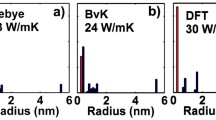Abstract
Reduction of thermal conductivity is important to enhance the performance of thermoelectric materials. One possible way to achieve this goal consists in embedding nanoparticles in the material, since they act as extrinsic phonon-scattering centers. In this paper, we study the effects of this embedding by means of a new formula for thermal conductivity obtained on the base of a hierarchy of hydrodynamical models which describe the transport of acoustic phonons in semiconductors. These models use as state variables suitable moments of the phonon occupation number, evolution equations of which are found starting from the Boltzmann–Peierls transport equation, and are closed by means of the maximum entropy principle. All the main interactions of phonons among themselves, with isotopes, nanoparticles, and boundaries are taken into account. Numerical results relative to the case of germanium nanoparticles embedded in a Si\(_{0.7}\)Ge\(_{0.3}\) alloy crystal show that the thermal conductivity can be significantly reduced even at room temperature.












Similar content being viewed by others
Notes
Due to accuracy problems in the numerical inversion, we cannot present results with a greater number of moments.
References
Ezzahri, Y., Joulain, K.: Dynamical thermal conductivity of bulk semiconductor crystals. J. Appl. Phys. 112(8), 083515 (2012)
Ezzahri, Y., Joulain, K.: Effect of embedding nanoparticles on the lattice thermal conductivity of bulk semiconductor crystals. J. Appl. Phys. 113(8), 043510 (2013)
Joseph, D.D., Preziosi, L.: Heat waves. Rev. Mod. Phys. 61, 41–73 (1989)
Mingo, N., Hauser, D., Kobayashi, N.P., Plissonnier, M., Shakouri, A.: Nanoparticle-in-alloy approach to efficient thermoelectrics: silicides in SiGe. Nano. Lett. 9(2), 711–715 (2009)
Morelli, D.T., Heremans, J.P., Slack, G.A.: Estimation of the isotope effect on the lattice thermal conductivity of group IV and group III–IV semiconductors. Phys. Rev. B 66, 094115 (2002)
Nika, D.L., Pokatilov, E.P., Askerov, A.S., Balandin, A.A.: Phonon thermal conduction in graphene: role of Umklapp and edge roughness scattering. Phys. Rev. B 79, 155413 (2009)
Volz, S.G.: Thermal insulating behavior in crystals at high frequencies. Phys. Rev. Lett. 87(7), 074301 (2001)
Kundu, A., Mingo, N., Broido, D.A., Stewart, D.A.: Role of light and heavy embedded nanoparticles on the thermal conductivity of SiGe alloys. Phys. Rev. B 84, 125426 (2011)
Mascali, G.: A new formula for thermal conductivity based on a hierarchy of hydrodynamical models. J. Stat. Phys. 163, 1268–1284 (2016)
Callaway, J.: Model for lattice thermal conductivity at low temperatures. Phys. Rev. 113(4), 1046–1051 (1959)
Mascali, G.: Maximum entropy principle in relativistic radiation hydrodynamics II: Compton and double Compton scattering. Contin. Mech. Thermodyn. 14(6), 549–561 (2002)
Reinecke, S., Kremer, G.M.: Method of moments of Grad. Phys. Rev. A 42(2), 815 (1990)
Struchtrup, H.: The BGK-model with velocity-dependent collision frequency. Contin. Mech. Thermodyn. 9(1), 23–31 (1997)
Alì, G., Mascali, G., Romano, V., Torcasio, R.C.: A hydrodynamical model for covalent semiconductors, with applications to GaN and SiC. Acta Appl. Math. 122(1), 335–348 (2012)
Camiola, V.D., Mascali, G., Romano, V.: Numerical simulation of a double-gate MOSFET with a subband model for semiconductors based on the maximum entropy principle. Contin. Mech. Thermodyn. 24(4–6), 417–436 (2012)
Mascali, G., Romano, V.: A non parabolic hydrodynamical subband model for semiconductors based on the maximum entropy principle. Math. Comput. Model. 55(3–4), 1003–1020 (2012)
Morandi, O., Barletti, L.: Particle dynamics in graphene: collimated beam limit. J. Comput. Theor. Transp. 43(1–7), 418–432 (2015)
Muscato, O., Di Stefano, V.: An energy transport model describing heat generation and conduction in silicon semiconductors. J. Stat. Phys. 144(1), 171–197 (2011)
Muscato, O., Di Stefano, V.: Hydrodynamic modeling of the electro-thermal transport in silicon semiconductors. J. Phys. A 44, 105501 (2011)
Romano, V., Zwierz, M.: Electron–phonon hydrodynamical model for semiconductors. Z. Angew. Math. Phys. 61, 1111–1131 (2010)
Acknowledgements
The research was supported by University of Calabria P.R.A.’s and by INDAM Progetto giovani 2015.
Author information
Authors and Affiliations
Corresponding author
Rights and permissions
About this article
Cite this article
Mascali, G. Thermal conductivity reduction by embedding nanoparticles. J Comput Electron 16, 180–189 (2017). https://doi.org/10.1007/s10825-016-0934-y
Published:
Issue Date:
DOI: https://doi.org/10.1007/s10825-016-0934-y




